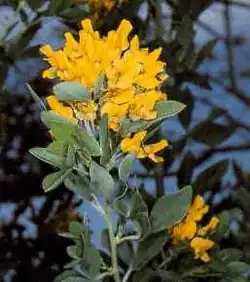Cytisus aeolicus
| Cytisus aeolicus | |
|---|---|

| |
| At the Conservatoire botanique national de Brest | |
_(8616926008).jpg)
| |
| Botanical illustration | |
| Scientific classification | |
| Kingdom: | Plantae |
| Clade: | Tracheophytes |
| Clade: | Angiosperms |
| Clade: | Eudicots |
| Clade: | Rosids |
| Order: | Fabales |
| Family: | Fabaceae |
| Subfamily: | Faboideae |
| Genus: | Cytisus |
| Species: | C. aeolicus
|
| Binomial name | |
| Cytisus aeolicus | |
| Synonyms[2] | |
| |
Cytisus aeolicus, the Aeolian broom, is a species of flowering plant in the family Fabaceae.[3][2] It is native to three of the Aeolian Islands; Vulcano, Lipari, and Stromboli.[2] Assessed as Endangered (previously Critically Endangered), it is a shrub or small tree, found in shrublands, garrigues, and disturbed soils.[1][2]

References
- ^ a b Troìa, A.; Domina, G. (2017). "Citiso delle Eolie Cytisus aeolicus". IUCN Red List of Threatened Species. 2017: e.T162068A120516087. doi:10.2305/IUCN.UK.2017-3.RLTS.T162068A120516087.en. Retrieved 14 August 2025.
Common names: Italian; Citiso delle Eolie, Sicilian; Sgurbio
- ^ a b c d "Cytisus aeolicus Guss". Plants of the World Online. Royal Botanic Gardens, Kew. Retrieved 14 August 2025.
- ^ D’Amico, Marcello; Bastianelli, Giulia; Faraone, Francesco Paolo; Lo Valvo, Mario (30 April 2018). "The spreading of the invasive Italian wall lizard on Vulcano, the last island inhabited by the critically endangered Aeolian wall lizard" (PDF). Herpetological Conservation and Biology. 13 (1): 146–157. Retrieved 14 August 2025.
